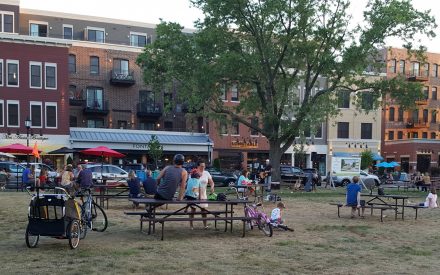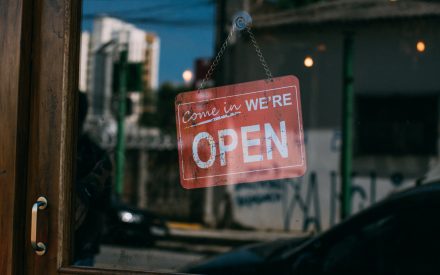Home » Programs » Downtown Toolbox » Example Business Owner Survey Questionnaire
Example Business Owner Survey Questionnaire
Once you have selected a survey technique or techniques, you must determine what questions you want to ask. Because business owners will want to spend a limited amount of time on a survey, you must design yours to ask only the most important questions. Unlike typical written surveys where respondents may remain anonymous, business owners must be identified so you can give them follow-up assistance. This is called an “open” business owner survey. Open surveys must avoid sensitive areas, such as income and expenditures. You can also design a second, anonymous business owner survey to collect sensitive information.
Information Sought in an Open Business Owner Survey
The following are kinds of information organizations such as economic development associations, chambers of commerce and the like typically seek in an open business owner survey. Use this list as a guide to formulating your questions. You will probably think of additional questions; your goal is to gather information that is most important to your market analysis efforts.
Contact Information
- Business name
- Owner
- Address
- Phone
Needs and Opportunities Assessment
- If they are experiencing any business challenges.
- What information or assistance could they or their employees could use?
- How useful are your organization’s existing products and services to their business?
- How useful would products and services proposed by your organization be to their business?
- What other business incentives or assistance have they used or plan to use?
- Their attitudes about being a business owner in your community.
- How satisfied they are with their present location?
- If they have plans to expand or reduce operations?
- If they, or the building owner, are considering any building improvement projects.
Business and Workforce Data
- Their business or professional activity code (NAICS).
- How long do they have been in operation?
- How long do they have owned the business?
- Whether their business owns or rents its space?
- How many square feet are devoted to sales, production, office and storage or are unused?
- How many people do they employ?
- Where their customers typically park?
- Where their employees typically park?
- What percentage of their employees lives in the local community?
Market and Marketing Data
- Their hours of operation and their thoughts on store hours.
- Their busiest times of the week.
- Their busiest months of the year.
- How many customers/clients visit their business per week?
- Community events that increased their foot traffic or sales volume.
- Top zip codes from which their business draws customers.
- Percentage of their annual advertising budget spent on various media.
- Their target market.
- Radio stations, publications, and other media included in their annual advertising budget.
- Products and/or services that best differentiate their business from the competition.
- Their toughest competition.
- Traits that make their business more competitive.
- Their target price point.
- Downtown businesses that complement their business the most.
- The biggest non-work reasons people stop downtown.
- Other businesses they would most like to see locate downtown.
- Community assets they would like to see developed (expand existing assets or create new ones).
Information Sought in an Anonymous Business Owner Survey
The ultimate goal for an anonymous business owner survey is to calculate sales per square foot, sales per employee, and rent per square foot. These statistics are calculated and used by chains, franchises and shopping centers for business planning but are not readily available for small independent downtown businesses. By pooling and summarizing this information, you can maintain confidentiality and still tell your downtown businesses how their sales and rent compare to similar businesses. You can also tell them how their rent compares to the average rent in your downtown. What’s more, you will also have generated valuable statistics for expansion and recruitment analysis, and for business planning. Use the following numbers to calculate the preceding statistics.
- Net sales;
- Annual rent;
- Gross leasable area in square feet;
- Number of full time equivalent (FTE) employees; and
- Wages.
Business Owner Survey Questionnaires
Wisconsin Main Street Program Standardized Business Owner Survey
The Wisconsin Main Street Program’s Standardized Business Owner Written Survey includes 35 questions in the following categories:
- Needs and Opportunities Assessment – Questions 1-9;
- Business and Workforce Data – Questions 10-18; and
- Market and Marketing Data – Questions 19-35.
Instruction for Customizing the Standardized Survey
When reviewing standardized questions for inclusion or omission, keep in mind that some of the questions in the Standardized Business Owner Written Survey are designed to be used together with questions from the Standardized Consumer Mail Survey. The paired questions allow for comparisons between the business owners’ answers and those of their current or potential customers.
Overall: Insert the name of your community wherever you see “City X”.
Cover Letter: Print the cover letter on your organization’s letterhead. Insert the correct dates, addresses, phone numbers, names, and signatures. The cover letter was designed for Wisconsin Main Street communities, so you may need to do some rewording. The survey instructions reflect the fact that the survey was designed for scanning and automated optical mark recognition. If you are planning to manually enter data, you may adjust the instructions accordingly.
Question 1: The standardized list under this question includes typical business challenges. Answers to this question should provide ideas for future business retention efforts. So if your local study team is aware of unique local challenges, feel free to expand the list. You may also reduce the list if you know a challenge is not an issue locally.
Question 2: The standardized list under this question includes typical business training workshop topics. If your local study team has additional training ideas, feel free to expand the list.
Question 3-4: The standardized list in question 3 includes typical products and services offered by Main Street organizations to assist their downtown businesses. Use the list to customize question 3 and 4 for your community. In question 3, list up to eight of your organization’s primary business assistance products and services, including any not found in the standardized list. In question 4, list up to four products and services your organization or community has seriously considered creating. Delete the extras. Also be sure to delete the instruction notations that are in italics.
Question 5: Question 5 is intended to provide feedback on the awareness and use of business assistance available to your downtown businesses through other programs. List up to four incentives your organization is most curious about and delete the rest.
Question 6: The statements in question 6 are intended to gauge attitudes that influence business behavior and to gauge perceptions about the downtown business climate. A range of possible statements is included in the standardized survey. You may want to eliminate statements that are not important to you, or add statements to address issues unique to your situation. You will have room for 16 statements.
Questions 3-6: This group of questions should occupy only one page. Prioritize the options/choices you include to stay at that length.
Question 11: Knowing the age of businesses in your downtown offers insight on where each business stands in its lifecycle, which in turn provides insight into its business assistance needs. Asking for a specific date in question 11 givesyour organization an opportunity to plan special events for businesses near their anniversary dates.
Question 22: This question can be simplified if you don’t expect a seasonal fluctuation in foot traffic.
Question 23: You should list all downtown events that your organization plans for the express purpose of increasing sales (retail events) or foot traffic (special events). Also include other major events taking place within the community or region that you want to evaluate for their impact on sales or foot traffic. If the number of events exceeds 12, you may want to consider only listing the most important. Choices should match question 8 from the Standardized Consumer Mail Survey.
Question 24: The purpose of this question is to 1) collect information that can be used to determine the primary trade area for the whole downtown, and 2) provide a gentle push to downtown businesses to collect information about the origin of their own customers (if they aren’t already). Asking customers their home zip codes is the easiest way for any business to begin tracking where their existing customers live. It is also information that can easily be shared with your organization without the business fearing they are giving away valuable secrets (such as the actual customer’s name or address). Furthermore, demographic data is available at the zip code level. The zip codes you list for this question should be those zip codes that your local study team intuitively believes have the greatest potential for selection by the most businesses. While each business will draw from a unique geographic area, the goal is to determine the area that generates the majority of the customers for your downtown. Please see the Trade Area Analysis section of the toolbox for more information.
Question 26: This is a question that many downtown business owners may have trouble answering. They may not have thought about their target market, but they should. It is almost never true that a business appeals to all demographic categories equally. The answer is important to your organization because when it is combined with the answers from all other downtown businesses you will be able to describe the most typically targeted downtown customer. The choices are designed to match questions 27, 28, and 34 in the Standardized Consumer Mail Survey and to match the standard census demographic categories.
Question 27: For this question it is important to list specific radio and television stations, publications and other media. It is important for your organization to know specific media outlets so you can better coordinate cooperative advertising opportunities. The list will also allow you to target your downtown image advertising to those broadcast outlets and publications preferred by your downtown businesses. List the primary local radio and television stations by using both the call letters and dial number to ensure business owners recognize their options. Be careful to make your lists complete. Choices should match question 37 from the Standardized Consumer Mail Survey.
Questions 28-31: These questions are designed to get downtown businesses to think about their competition and what sets them apart in the eyes of their customers. Answers to these questions are more important to the business owners themselves, but may prove useful to your organization.
Question 32: Like questions 28-31, answers to this question are more important to the business owners themselves. Encouraging businesses to take the time to think about other specific downtown businesses that complement their own may help foster future cooperative advertising and promotions.
Question 34: List the businesses for which you are most interested in evaluating market potential. This is your wish list of businesses. Choices should match question 18 from the Standardized Consumer Mail Survey. Asking business owners this question will help identify potential complementary businesses.
Question 35: Customize the list of choices for question 35 to include community development projects planned or proposed through comprehensive planning, town meetings, or strategic/work planning. Choices should match question 20 from the Standardized Consumer Mail Survey.
Customized Business Owner Surveys (Ohio, Vermont, Wisconsin)
Customized and shortened versions of the Wisconsin Main Street Program’s Standardized Business Owner Written Survey provide additional examples for your use. The sample survey instruments that follow may include some additional questions not in the Wisconsin standardized survey. They can be downloaded in Portable Document Format (.pdf) here.
![]() Main Street Warren, Ohio, Business Owner Survey
Main Street Warren, Ohio, Business Owner Survey
- City population: 46,000
- User: Ohio State University Extension
- Used both web-based and written survey instruments.
![]() Newport, Vermont, Business Operators Survey
Newport, Vermont, Business Operators Survey
- City population: 5,000
- User: University of Vermont-Extension
- Used with a scannable written survey.
![]() Downtown Madison, Wisconsin, Business Operators Survey
Downtown Madison, Wisconsin, Business Operators Survey
- City population: 240,000
- User: University of Wisconsin-Extension
- Used with a scannable written survey and a web-based survey instrument.
Administering the Business Owner Survey
The best way to ensure successful administration of any project, including a business owner survey, is to develop and follow a work plan. Work plans are a fundamental strategy employed by Main Street and downtown revitalization organizations across the United States. Below we outline tasks identified for a hypothetical business owner, written survey work plan. Many of the steps assume you are using the Standardized Business Owner Written Survey developed by the Wisconsin Main Street Program.
Step 1. Review Examples from Other Communities
Many communities have administered a business owner written survey and most are more than happy to share their methods and results. There is little advantage in trying to design your business owner written survey from scratch. If your community is like most, you will lack volunteers with significant survey design experience. It is easy to make costly mistakes. If a question is poorly worded, it will yield less useful or even incorrect information. If your community has administered a business owner written survey in the past, consider using some of the same questions in order to see if answers, and thus businesses, have changed over time.
For answers to be useful, questions must be unambiguous and should not lead the business owner to a particular response. Asking about existing behavior is the best way to predict future behavior. For easier analysis and interpretation, to the extent possible ask multiple choice rather than open-ended questions. Match questions on demographics with census categories so they can be compared. Even subtle differences in the wording of similar questions will prevent comparisons. This advice is not meant to discourage you from administering your own business owner written survey, but we do encourage you to be cautious when writing questions.
Step 2. Accept/Reject Standardized Questions
The Standardized Business Owner Written Survey (in Appendix 1) includes questions that Wisconsin Main Street Program staff consider important in a comprehensive downtown market analysis and useful for business retention, expansion and recruitment. You are free to eliminate questions that are not important to your efforts. Keep in mind that each question you use as designed will allow you to compare answers from with other communities that used the same question. This cross-community comparison will enhance the power of your survey. You should not modify the wording of a question without good reason. If you believe questions should be modified, please contact the Wisconsin Main Street Program so we can consider revising the standardized survey.
When reviewing standardized questions for inclusion or omission from your survey, remember that you will want to pair some with questions from your consumer survey. The paired questions allow for comparisons between the perceptions, attitudes and behaviors of business owners and their potential customers.
Step 3. Draft Customized Questions
Always customize any borrowed survey questions to fit your unique local needs. The Standardized Business Owner Written Survey provided includes questions you can personalize. We also provide instructions for personalization in Appendix
Step 4. Draft Introduction
An introduction is an important part of any type of survey. For written and web-based surveys, the introduction is usually included in a cover letter. For telephone surveys, business visitations and focus groups, the introduction will be presented verbally. The introduction should explain how the survey results will help the owner’s business. It should also include instructions and an estimate of the amount of time required to take it, state that only aggregate data will be made public, and ask for participation.
Step 5. Proofread and Pretest Your Survey
It is always good practice to proofread and pretest your survey, including your cover letter, before full distribution. Sometimes volunteers drafting the customized questions get too close to their work and fail to see the obvious. Have a few business owners who are active volunteers in your organization, but who have not been involved in survey design, take your business owner written survey and give you feedback. Instructions and questions that are unclear and misinterpreted will show up in a pretest and can be corrected. Use the pretest to estimate the time required to take the survey.
Step 6. Approve Final Survey
Eventually, editing must come to an end. Because distribution and collection require a significant commitment of volunteer time and energy, it is important to have the organization or committee overseeing the project formally approve the final version of your business owner written survey.
Step 7. Answer Distribution Questions
To establish your organization and community as business friendly, as well as aid in business retention, you should aim for a 100 percent response rate for your business owner written survey. You can achieve this level of response only by hand delivering surveys to every business owner and personally explaining the importance of their participation. Your resources will determine how you accomplish hand delivering the surveys. You may need to use volunteers; if so, it’s a good idea to recruit them from owners of businesses or buildings and name some of them “block captains.” Block captains take responsibility for distributing and collecting the surveys to others on their block. (Once recruited, you can also ask block captains to distribute other information, as needed, to businesses on their block.)
Step 8: Develop Distribution Plan
To stay on task, you must set deadlines for delivery and collection of your business owner written survey and assign specific responsibilities. We also suggest you mail a letter ahead of time announcing future delivery of the survey. In addition, we recommend announcing survey plans in your organization’s newsletter and press releases. Business owners will be much more likely to participate if they understand the project and why it will help their business. Finally, it is important to train the staff or volunteers who will be delivering and collecting the survey.
Step 9. Print Survey
The number of businesses you plan to survey will affect your printing decisions. Photocopying surveys is more cost effective for low volumes, while professional printing is more cost effective for high volumes. If photocopying, make sure the quality of the copy is good. Stray marks that sometimes show up on poor copies could affect the accuracy of computerized optical mark recognition software.
Step 10. Distribute Surveys
The printed surveys from Step 9 need to be hand delivered to every business owner. Although the cover letter explains how the survey will help the owner’s business, provides instructions and asks for participation, volunteers should repeat the same messages at the time of delivery. Give business owners an estimate of the amount of time required to complete the survey and when to expect a return visit for collection.
Step 11. Collect Surveys
Again, your goal is a 100 percent response rate and that can only be accomplished face to face. If a business owner has not completed his or her survey by the deadline, the individual collecting surveys should schedule a new return visit with the business owner. (Obviously, this also requires building late returns into your schedule). You could also switch techniques at this point and conduct business visitations to survey business owners slow in returning the surveys.
Step 12. Tabulate Surveys
Enter data into a spreadsheet or database program. The Wisconsin Main Street Program’s Standardized Business Owner Written Survey is scannable for automatic data entry.
Step 13. Verify Data and Enter Open Ended Responses
While most computerized optical mark recognition software is surprisingly accurate, there are always answers that will be unrecognized or incorrectly recorded. In addition, most programs are still unable to automatically recognize handwriting and open-ended responses. For these reasons it is necessary for someone, preferably a volunteer, to verify and correct any errors in scanned answers, as well as type hand-written open-ended answers. You will also need to transfer information to the business portion of the downtown inventory—including owner contact information, business classification, primary products and services, date established, business hours, space use, and employment information.
Step 14. Review Raw Data
The simplest way to summarize survey results is to report the frequency of each response to each question.
Step 15: Summarize/Interpret Data
With frequencies in hand, look for patterns in the results that would be useful for your downtown business owners to know. Also, make note of “red flags” that might warn of the need for business assistance. Finally, take care to protect the confidentiality of the information collected.
Step 16. Review and Print Summary
Invest your human and financial resources in quality editing, rather than expensive printing.
Step 17. Distribute Summary
Remember to share the results of your survey with your business owners. Mail or hand delivers the summary report to them. Sharing this information is a valuable business retention activity. The report will demonstrate the importance of the time they spent filling out the survey, as well as how they might personally benefit from the results.
Step 18. Repeat
Your organization should plan to survey business owners on a regular basis, ideally every year, but at least every other year. For questions where the answer is unlikely to be different from the last time you surveyed, include owners’ former answers and allow them to change it if necessary. Use the exact wording for as many questions as possible in order to see if answers, and thus businesses, have changed over time.
About the Toolbox and this Section
The 2022 update of the toolbox marks over two decades of change in our small city downtowns. It is designed to be a resource to help communities work with their Extension educator, consultant, or on their own to collect data, evaluate opportunities, and develop strategies to become a stronger economic and social center. It is a teaching tool to help build local capacity to make more informed decisions.
This free online resource has been developed and updated by over 100 university educators and graduate students from the University of Wisconsin – Madison, Division of Extension, the University of Minnesota Extension, the Ohio State University Extension, and Michigan State University – Extension. Other downtown and community development professionals have also contributed to its content.
The toolbox is aligned with the principles of the National Main Street Center. The Wisconsin Main Street Program was a key partner in the development of the initial release of the toolbox. One of the purposes of the toolbox has been to expand the examination of downtowns by involving university educators and researchers from a broad variety of perspectives.
The current contributors to each section are identified by name and email at the beginning of each section. For more information or to discuss a particular topic, contact us.
















